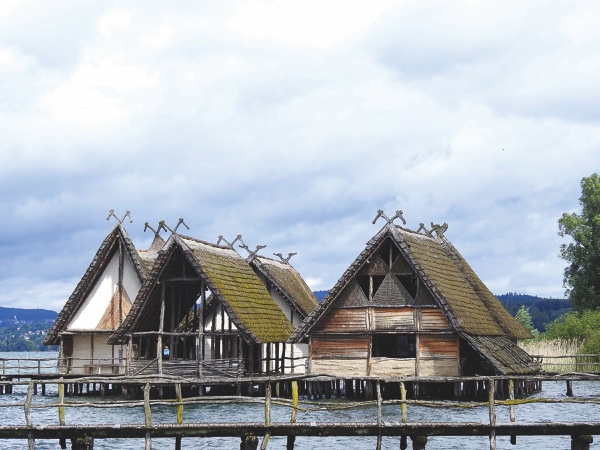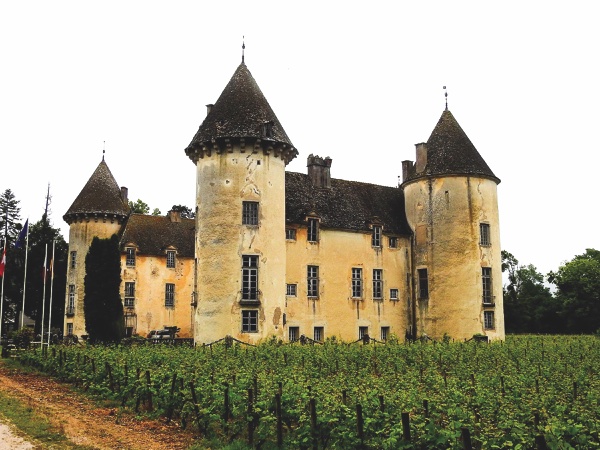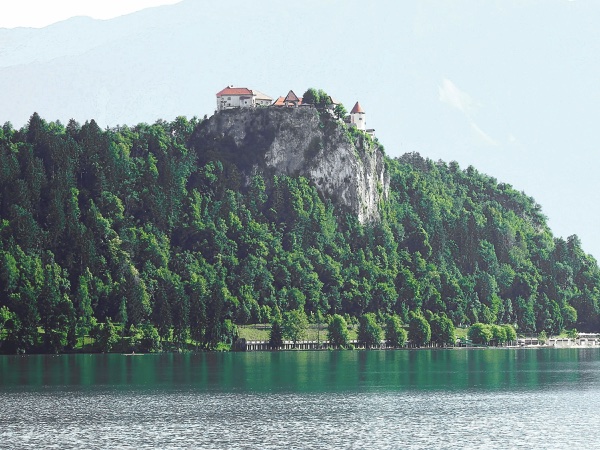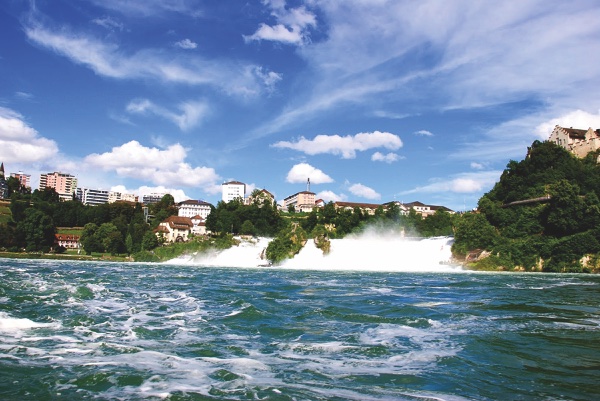Traveling on your own, even with the best guidebooks, can still be confusing. Take the Bodensee Lake in Germany. It is also called Lake Constance and sometimes the Swabian Sea. Lake Constance is the international name which is derived from the local town of Konstanz. Bodensee is the German name for the lake due to the nearby town of Bodman. The Lake, by any name, is the only area in Europe with no defined borders as it borders Switzerland, Germany, and Austria! My friends were looking for out-of-the-way places and this was it. Why? Because NO TOURISTS go there. It also means very few people speak English. Ordering food was especially interesting for them with a lot of guess work on what they would finally be served. But, that the interesting part of travel – experiencing new thing, new areas, things you won’t see or find in Del Webb, right?

A stick house in a stone- age village called the Pile Dwellings of Unteruhldingen. (Photos provided)
They stayed in an “old petite palace” on the lake that had been renovated into 18 condos (think Airbnb). It was very high end but totally weird and dysfunctional, while being striking. There were no lights in most places and only a few in others so you found yourself groping around like a blind person. A phone flashlight helped. The owner LOVED mirrors. Everywhere! Even on the bathroom door facing the toilet! The oddest part about the condo was the huge glass window between the shower and the living room. With no TV, I guess this was for entertainment! Otherwise, there was a second shower curtain you could pull across the window, but having two shower curtains created some sort of shower vortex that sucked you into them. More fun and things to laugh about when you get home!
Mainau Island, in Lake Constantine, belonged to the Teutonic Knights from the 13th-19th century and then was passed to Grand Duke Friedrich I of Baden, who was quite the botanist. The island has a unique climate, due to its location in the lake, which allows a very broad array of flowers and plants to flourish.

Over time, the island went to his daughter, who became Queen of Sweden, and now is owned by her son. The Butterfly House on the island has hundredss of different varieties. The island has probably the only Swedish restaurant in Germany. Excellent food and actually serves reindeer.
Graf Zepplin was born in Konstanz which hosts the Zepplin museum also on the Bodensee. They reconstructed part of the Hindenberg for you to walk through; very classy. The original Hindenburg blew up at its berth in Lindenhurst N.J. because it was filled with hydrogen (flammable) vs. helium (non-flammable) because the U.S. wouldn’t sell helium to Germany due to its military utility and scarcity at the time. During the war, the Germans converted the airship factory into an airplane engine and rocket factory. All the workers had been conscripted from the concentration camps. Allied air forces bombed the factory and town in a very diligent manner. No GPS targeting back then so virtually everything was destroyed. It was the only town on the Bodensee they felt wasn’t quaint and attractive.
A unique stop on their trip was the “Sticks in the Mud” stone age village; the Pile Dwellings of Unteruhldingen (love German!). They are a submerged World Heritage site that has now been made visible. There were many, many of these “stick house villages” built on stilts in the Lake in ancient times – like the Stone Age through the Bronze Age. Settlements first occurred around the lake circa 6000 BC (Neolithic age) and these villages were created and lived in/on the lake until about 850 BC when the climate worsened.
Leaving the lake, they decided to go see Europe’s largest waterfall – the Rheinfall. Note that they said largest NOT tallest. But still very terrific. It had rained most of the week so the falls were at peak performance.

My friends trip was extremely fluid as they were on their own, no timetable, other than the flight home, so they modified their adventures as they traveled and moved between countries with ease. At one point they visited the Ludwigsburg Residential Palace in Ludwigsburg, Germany. The Palace had the most amazing gardens, so much so they rated it the best they had ever seen. Since it was so amazing, they wondered “How did the owner pay for it?” “Well”, they were told, “He sold the male children of his villagers off as mercenaries.” This was during the 30 Years War so he had a long term business opportunity.
They then took a day trip from Ludwigsburg to Rothenburg ob der Tauber, which is on the Romantic Road, so called for its many charming towns. This was a second visit to the area from years past and it had impressed them enough to return for an encore. The town was saved from destruction during the 30 Years war by a beer drinking contest. To stop the fighting, the local draught master, Meistertrunk, challenged the head invader to a challenge, i.e. drink a giant stein of beer in one quaff. Whoever does it, wins the town. When the invader failed, Meistertrunk went right at it, chugged it down, and saved the town. An elaborate clock in the town depicts that epic moment. So if we’re ever invaded by another town, there’s an easy way to end it!
Another stop in Germany was in this little town called Esslingen which they considered excruciatingly cute and fun. They shopped in the market, had breakfast and then stopped by the champagne brewery at 10:30 in the morning at the suggestion of a local who had begun drinking well before 10. So, they joined the locals and downed a few bubbles. More adventures for the adventuresome.

After driving into France, they stayed in a tiny village called Villers-la-Faye in a 450+ year-old winemakers cottage. The village was about 10 minutes from Beaune, the epicenter of Burgundian winemaking. Besides the wine, Beaune’s claim to fame is the Hospices de Beaune. Founded in 1443 by Nicholas Rolin to care for the wounded of The Hundred Years War it wasn’t called a Hospice for nothing. An informative sign pointed out that your chances of surviving your stay were roughly equal to “being thrown into a ditch.” Very encouraging, if that’s where you’re being taken! It continued as a hospice until 1971 when it moved into a more modern facility. The Hospice was financed by Rolin’s substantial holdings of top quality vineyards that to this day are producing fine wines; prices start at $140 US per bottle.
As I get more updates, I will continue their story. Stay tuned for Part 4.




